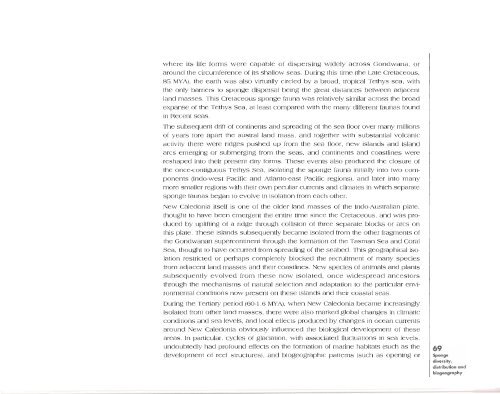Sponges of the New Caledonian lagoon - IRD
Sponges of the New Caledonian lagoon - IRD
Sponges of the New Caledonian lagoon - IRD
You also want an ePaper? Increase the reach of your titles
YUMPU automatically turns print PDFs into web optimized ePapers that Google loves.
where its life forms were capable <strong>of</strong> dispersing widely across Gondwana. or<br />
around <strong>the</strong> circumference <strong>of</strong> its shallow seas. During this time (<strong>the</strong> Late Cretaceous.<br />
85 MYA). <strong>the</strong> earth was also virtually circled by a broad. tropical Tethys sea. with<br />
<strong>the</strong> only barriers to sponge dispersal being <strong>the</strong> great distances between adjacent<br />
land masses. This Cretaceous sponge fauna was relatively similar across <strong>the</strong> broad<br />
expanse <strong>of</strong> <strong>the</strong> Tethys Sea. at least compared with <strong>the</strong> many different faunas found<br />
in Recent seas.<br />
The subsequent drift <strong>of</strong> continents and spreading <strong>of</strong> <strong>the</strong> sea floor over many millions<br />
<strong>of</strong> years tore apart <strong>the</strong> austral land mass. and toge<strong>the</strong>r with substantial volcanic<br />
activity <strong>the</strong>re were ridges pushed up from <strong>the</strong> sea floor. new islands and island<br />
arcs emerging or submerging from <strong>the</strong> seas. and continents and coastlines were<br />
reshaped into <strong>the</strong>ir present day forms. These events also produced <strong>the</strong> closure <strong>of</strong><br />
<strong>the</strong> once-contiguous Tethys Sea. isolating <strong>the</strong> sponge fauna initially into two components<br />
(lndo-west Pacific and Atlanto-east Pacific regions). and later into many<br />
more smaller regions with <strong>the</strong>ir own peculiar currents and climates in which separate<br />
sponge faunas began to evolve in isolation from each o<strong>the</strong>r.<br />
<strong>New</strong> Caledonia itself is one <strong>of</strong> <strong>the</strong> older land masses <strong>of</strong> <strong>the</strong> tndo-Australian plate.<br />
thought to have been emergent <strong>the</strong> entire time since <strong>the</strong> Cretaceous. and was produced<br />
by uplifting <strong>of</strong> a ridge through collision <strong>of</strong> three separate blocks or arcs on<br />
this plate. These islands subsequently became isolated from <strong>the</strong> o<strong>the</strong>r fragments <strong>of</strong><br />
<strong>the</strong> Gondwanan supercontinent through <strong>the</strong> formation <strong>of</strong> <strong>the</strong> Tasman Sea and Coral<br />
Sea. thought to have occurred from spreading <strong>of</strong> <strong>the</strong> seabed. This geographical isolation<br />
restricted or perhaps completely blocked <strong>the</strong> recruitment <strong>of</strong> many species<br />
from adjacent land masses and <strong>the</strong>ir coastlines. <strong>New</strong> species <strong>of</strong> animals and plants<br />
subsequently evolved from <strong>the</strong>se now isolated. once Widespread ancestors<br />
through <strong>the</strong> mechanisms <strong>of</strong> natural selection and adaptation to <strong>the</strong> particular environmental<br />
conditions now present on <strong>the</strong>se islands and <strong>the</strong>ir coastal seas.<br />
During <strong>the</strong> Tertiary period (60-1 .6 MYA). when <strong>New</strong> Caledonia became increasingly<br />
isolated from o<strong>the</strong>r land masses. <strong>the</strong>re were also marked global changes in climatic<br />
conditions and sea levels. and local effects produced by changes in ocean currents<br />
around <strong>New</strong> Caledonia obViously influenced <strong>the</strong> biological development <strong>of</strong> <strong>the</strong>se<br />
areas. In particular. cycles <strong>of</strong> glaciation. with associated fluctuations in sea levels.<br />
undoubtedly had pr<strong>of</strong>ound effects on <strong>the</strong> formation <strong>of</strong> marine habitats (such as <strong>the</strong><br />
development <strong>of</strong> reef structures). and biogeographic patterns (such as opening or<br />
69<br />
Sponge<br />
diversity,<br />
distribution and<br />
biogeography

















